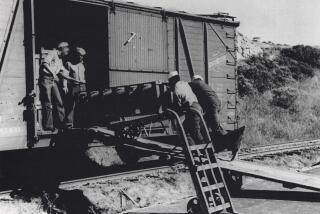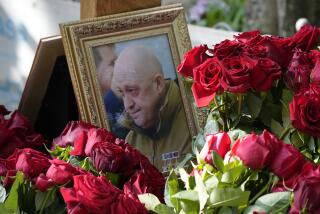Navy Raises Possibility Iowa Explosion Was Accidental : Inquiry: Based on new tests, the service is reassessing its earlier conclusion that one sailor caused the blast that killed 47 shipmates.
- Share via
WASHINGTON — The Navy, having completed new tests to determine the cause of a 1989 explosion on the battleship Iowa, is reassessing its conclusion that one sailor--depressed over the loss of a friendship--masterminded the blast that killed 47 of his shipmates, defense officials said Thursday.
“There is a small probability it (the explosion) could have been accidental,” a Navy official said Thursday. He cautioned, however, that test results are still inconclusive and that no final report will be issued until the end of the summer.
“There may be some backing away from the Navy’s earlier position,” a senior Pentagon official said. “It will not be as conclusive as the Navy’s first set of findings.”
Furthermore, the official said, the Navy may never be able to determine exactly what caused the explosion in the turret of one of the Iowa’s huge 16-inch guns.
The new tests were conducted by naval technical experts and scientists at Sandia National Laboratory in New Mexico as part of a new investigation ordered in May, 1990, by Navy Secretary H. Lawrence Garrett III.
If the final report disputes the earlier findings, the Navy could face lawsuits by the families of the two sailors earlier implicated in the blast. The tragedy already has contributed to the Navy’s decision to retire all four of the World War II-vintage battlewagons. The Iowa was decommissioned last year.
The Navy’s acknowledgement that its earlier findings might be incorrect is also likely to accelerate efforts to change the way the military services investigate their own accidents.
“These guys never admit when they’re wrong,” said Rep. Mary Rose Oakar (D-Ohio), who had pressed for a review of the Navy’s findings. “They have got to apologize publicly . . . and allow those grieving parents some satisfaction. And they have to change their ways. I don’t think they’re capable of investigating themselves, certainly not at this time.”
The explosion occurred in April, 1989, during a naval exercise off the southeastern coast of the United States. It led the Navy to ban the firing of the big guns until the investigation was completed in September, 1989.
After a six-month inquiry, Rear Adm. Richard D. Milligan told Navy leaders that the blast was “most probably” caused deliberately by Petty Officer 2nd Class Clayton M. Hartwig, the gunner’s mate in the turret at the time of the explosion. He determined that the battleship’s 16-inch guns were safe to operate.
Milligan, backed by criminal investigators from the Naval Investigative Service and the FBI, concluded also that Hartwig--who died in the explosion--might have inserted a chemical detonator into the bags of gunpowder after his friendship with another sailor, Petty Officer Kendall Truitt, ended. At the same time, no “plausible cause” was found for any accidental detonation of the gunpowder.
Although the Navy’s most senior officers accepted the findings, the investigation remained controversial on Capitol Hill, where skeptical lawmakers directed independent scientists to review the technical findings.
By May, 1990, scientists testing gunpowder at Sandia experienced an “unexplained ignition,” raising the possibility that the original blast might have been accidental rather than an intentional act. Navy Secretary Garrett then ordered the inquiry reopened.
In tests since then, the Sandia scientists have found evidence to dispute many of the test results that the Navy cited when it ruled out accidental causes.
For example, the original investigation found no plausible circumstances that would cause an accidental explosion of gunpowder and found also what investigators described as traces of a chemical detonator that could only have been placed inside the gun barrel intentionally.
The Sandia findings have shown that there are several circumstances that can lead to detonations and have questioned the Navy’s insistence that chemicals found inside the barrel of the gun were clear evidence that a detonator had been inserted.
More to Read
Sign up for Essential California
The most important California stories and recommendations in your inbox every morning.
You may occasionally receive promotional content from the Los Angeles Times.














